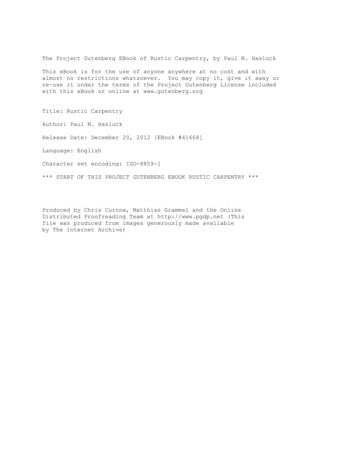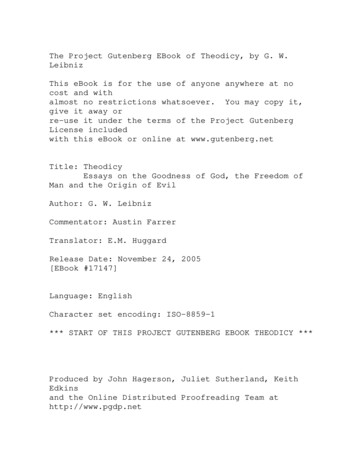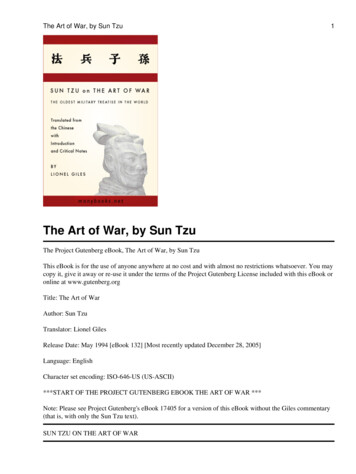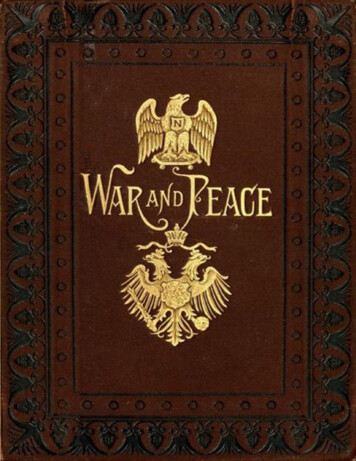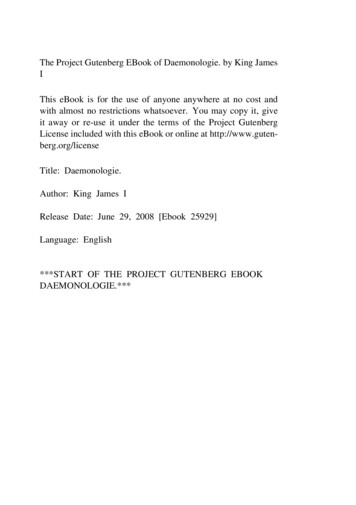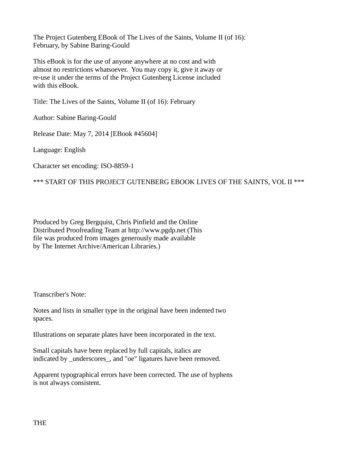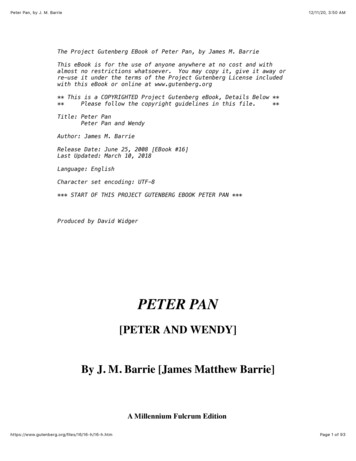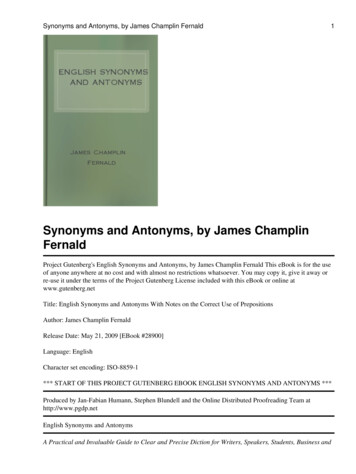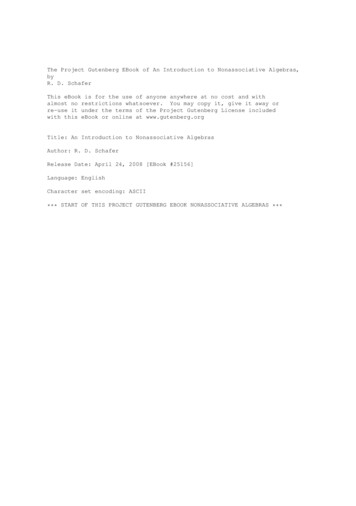
Transcription
The Project Gutenberg EBook of An Introduction to Nonassociative Algebras,byR. D. SchaferThis eBook is for the use of anyone anywhere at no cost and withalmost no restrictions whatsoever. You may copy it, give it away orre-use it under the terms of the Project Gutenberg License includedwith this eBook or online at www.gutenberg.orgTitle: An Introduction to Nonassociative AlgebrasAuthor: R. D. SchaferRelease Date: April 24, 2008 [EBook #25156]Language: EnglishCharacter set encoding: ASCII*** START OF THIS PROJECT GUTENBERG EBOOK NONASSOCIATIVE ALGEBRAS ***
AN INTRODUCTION TONONASSOCIATIVE ALGEBRASR. D. SchaferMassachusetts Institute of TechnologyAn Advanced Subject-Matter Institute in AlgebraSponsored byThe National Science FoundationStillwater, Oklahoma, 1961
Produced by David Starner, David Wilson, Suzanne Lybarger and theOnline Distributed Proofreading Team at http://www.pgdp.netTranscriber’s notesThis e-text was created from scans of the multilithed bookpublished by the Department of Mathematics at OklahomaState University in 1961. The book was prepared formultilithing by Ann Caskey.The original was typed rather than typeset, which somewhatlimited the symbols available; to assist the reader we havehere adopted the convention of denoting algebras etc byfraktur symbols, as followed by the author in his substantiallyexpanded version of the work published under the same titleby Academic Press in 1966.Minor corrections to punctuation and spelling and minormodifications to layout are documented in the LATEX source.
iiiThese are notes for my lectures in July, 1961, at the AdvancedSubject Matter Institute in Algebra which was held at Oklahoma StateUniversity in the summer of 1961.Students at the Institute were provided with reprints of my paper,Structure and representation of nonassociative algebras (Bulletin of theAmerican Mathematical Society, vol. 61 (1955), pp. 469–484), togetherwith copies of a selective bibliography of more recent papers on nonassociative algebras. These notes supplement §§3–5 of the 1955 Bulletinarticle, bringing the statements there up to date and providing detailedproofs of a selected group of theorems. The proofs illustrate a numberof important techniques used in the study of nonassociative algebras.R. D. SchaferStillwater, OklahomaJuly 26, 1961
I.IntroductionBy common consent a ring R is understood to be an additiveabelian group in which a multiplication is defined, satisfying(1)(xy)z x(yz)(2)(x y)z xz yz,for all x, y, z in Randz(x y) zx zyfor all x, y, z in R,while an algebra A over a field F is a ring which is a vector space overF with(3)α(xy) (αx)y x(αy)for all α in F , x, y in A,so that the multiplication in A is bilinear. Throughout these notes,however, the associative law (1) will fail to hold in many of the algebraicsystems encountered. For this reason we shall use the terms “ring” and“algebra” for more general systems than customary.We define a ring R to be an additive abelian group with a secondlaw of composition, multiplication, which satisfies the distributive laws(2). We define an algebra A over a field F to be a vector space overF with a bilinear multiplication (that is, a multiplication satisfying(2) and (3)). We shall use the name associative ring (or associativealgebra) for a ring (or algebra) in which the associative law (1) holds.In the general literature an algebra (in our sense) is commonlyreferred to as a nonassociative algebra in order to emphasize that (1)is not being assumed. Use of this term does not carry the connotationthat (1) fails to hold, but only that (1) is not assumed to hold. If (1)is actually not satisfied in an algebra (or ring), we say that the algebra(or ring) is not associative, rather than nonassociative.As we shall see in II, a number of basic concepts which are familiarfrom the study of associative algebras do not involve associativity in anyway, and so may fruitfully be employed in the study of nonassociativealgebras. For example, we say that two algebras A and A0 over F areisomorphic in case there is a vector space isomorphism x x0 betweenthem with(4)(xy)0 x0 y 0for all x, y in A.1
2INTRODUCTIONAlthough we shall prove some theorems concerning rings andinfinite-dimensional algebras, we shall for the most part be concernedwith finite-dimensional algebras. If A is an algebra of dimension n overF , let u1 , . . . , un be a basis for A over F . Then the bilinear multiplication in A is completely determined by the n3 multiplication constantsγijk which appear in the products(5)ui uj nXγijk uk ,γijk in F .k 1We shall call the n2 equations (5) a multiplication table, and shall sometimes have occasion to arrange them in the familiar form of such a table:u1.ui.unu1 . . . uj . . . un.P.γijk uk . . .The multiplication table for a one-dimensional algebra A over F isgiven by u21 γu1 (γ γ111 ). There are two cases: γ 0 (from whichit follows that every product xy in A is 0, so that A is called a zeroalgebra), and γ 6 0. In the latter case the element e γ 1 u1 serves as abasis for A over F , and in the new multiplication table we have e2 e.Then α αe is an isomorphism between F and this one-dimensionalalgebra A. We have seen incidentally that any one-dimensional algebrais associative. There is considerably more variety, however, among thealgebras which can be encountered even for such a low dimension astwo.Other than associative algebras the best-known examples of algebras are the Lie algebras which arise in the study of Lie groups. A Liealgebra L over F is an algebra over F in which the multiplication isanticommutative, that is,(6)x2 0(implying xy yx),and the Jacobi identity(7)(xy)z (yz)x (zx)y 0for all x, y, z in L
INTRODUCTION3is satisfied. If A is any associative algebra over F , then the commutator(8)satisfies(60 )and(70 )[x, y] xy yx[x, x] 0hihihi[x, y], z [y, z], x [z, x], y 0.Thus the algebra A obtained by defining a new multiplication (8) inthe same vector space as A is a Lie algebra over F . Also any subspaceof A which is closed under commutation (8) gives a subalgebra of A ,hence a Lie algebra over F . For example, if A is the associative algebraof all n n matrices, then the set L of all skew-symmetric matricesin A is a Lie algebra of dimension 12 n(n 1). The Birkhoff-Witt theorem states that any Lie algebra L is isomorphic to a subalgebra of an(infinite-dimensional) algebra A where A is associative. In the generalliterature the notation [x, y] (without regard to (8)) is frequently used,instead of xy, to denote the product in an arbitrary Lie algebra.In these notes we shall not make any systematic study of Lie algebras. A number of such accounts exist (principally for characteristic0, where most of the known results lie). Instead we shall be concernedupon occasion with relationships between Lie algebras and other nonassociative algebras which arise through such mechanisms as the derivation algebra. Let A be any algebra over F . By a derivation of A is meanta linear operator D on A satisfying(9)(xy)D (xD)y x(yD)for all x, y in A.The set D(A) of all derivations of A is a subspace of the associativealgebra E of all linear operators on A. Since the commutator [D, D0 ]of two derivations D, D0 is a derivation of A, D(A) is a subalgebra ofE ; that is, D(A) is a Lie algebra, called the derivation algebra of A.Just as one can introduce the commutator (8) as a new productto obtain a Lie algebra A from an associative algebra A, so one canintroduce a symmetrized product(10)x y xy yxin an associative algebra A to obtain a new algebra over F where thevector space operations coincide with those in A but where multiplication is defined by the commutative product x y in (10). If one is
4INTRODUCTIONcontent to restrict attention to fields F of characteristic not two (as weshall be in many places in these notes) there is a certain advantage inwriting(100 )x · y 12 (xy yx)to obtain an algebra A from an associative algebra A by definingproducts by (100 ) in the same vector space as A. For A is isomorphicunder the mapping a 21 a to the algebra in which products are definedby (10). At the same time powers of any element x in A coincide withthose in A: clearly x · x x2 , whence it is easy to see by induction onn that x · x · · · · · x (n factors) (x · · · · · x) · (x · · · · · x) xi · xn i 1(xi xn i xn i xi ) xn .2If A is associative, then the multiplication in A is not only commutative but also satisfies the identity(11)(x · y) · (x · x) x · [y · (x · x)]for all x, y in A .A (commutative) Jordan algebra J is an algebra over a field F in whichproducts are commutative:(12)xy yxfor all x, y in J,and satisfy the Jordan identity(110 )(xy)x2 x(yx2 )for all x, y in J.Thus, if A is associative, then A is a Jordan algebra. So is any subalgebra of A , that is, any subspace of A which is closed under thesymmetrized product (100 ) and in which (100 ) is used as a new multiplication (for example, the set of all n n symmetric matrices). Analgebra J over F is called a special Jordan algebra in case J is isomorphic to a subalgebra of A for some associative A. We shall see thatnot all Jordan algebras are special.Jordan algebras were introduced in the early 1930’s by a physicist, P. Jordan, in an attempt to generalize the formalism of quantummechanics. Little appears to have resulted in this direction, but unanticipated relationships between these algebras and Lie groups and thefoundations of geometry have been discovered.
INTRODUCTION5The study of Jordan algebras which are not special depends uponknowledge of a class of algebras which are more general, but in a certainsense only slightly more general, than associative algebras. These arethe alternative algebras A defined by the identities(13)and(14)x2 y x(xy)for all x, y in Ayx2 (yx)xfor all x, y in A,known respectively as the left and right alternative laws. Clearly anyassociative algebra is alternative. The class of 8-dimensional Cayleyalgebras (or Cayley-Dickson algebras, the prototype having been discovered in 1845 by Cayley and later generalized by Dickson) is, as weshall see, an important class of alternative algebras which are not associative.To date these are the algebras (Lie, Jordan and alternative) aboutwhich most is known. Numerous generalizations have recently beenmade, usually by studying classes of algebras defined by weaker identities. We shall see in II some things which can be proved about completely arbitrary algebras.
II.Arbitrary Nonassociative AlgebrasLet A be an algebra over a field F . (The reader may make theappropriate modifications for a ring R.) The definitions of the termssubalgebra, left ideal, right ideal, (two-sided) ideal I, homomorphism,kernel of a homomorphism, residue class algebra A/I (difference algebraA I), anti-isomorphism, which are familiar from a study of associativealgebras, do not involve associativity of multiplication and are thusimmediately applicable to algebras in general. So is the notation BCfor the subspace of A spanned by all products bc with b in B, c in C(B, C being arbitrary nonempty subsets of A); here we must of coursedistinguish between (AB)C and A(BC), etc.We have the fundamental theorem of homomorphism for algebras:If I is an ideal of A, then A/I is a homomorphic image of A under thenatural homomorphism(1)a a a I,a in A, a I in A/I.Conversely, if A0 is a homomorphic image of A (under the homomorphism(2)a a0 ,a in A, a0 in A0 ),then A0 is isomorphic to A/I where I is the kernel of the homomorphism.If S0 is a subalgebra (or ideal) of a homomorphic image A0 of A,then the complete inverse image of S0 under the homomorphism (2)—that is, the set S {s A s0 S0 }—is a subalgebra (or ideal) of Awhich contains the kernel I of (2). If a class of algebras is defined byidentities (as, for example, Lie, Jordan or alternative algebras), thenany subalgebra or any homomorphic image belongs to the same class.We have the customary isomorphism theorems:(i) If I1 and I2 are ideals of A such that I1 contains I2 , then(A/I2 )/(I1 /I2 ) and A/I1 are isomorphic.(ii) If I is an ideal of A and S is a subalgebra of A, then I Sis an ideal of S, and (I S)/I and S/(I S) are isomorphic.6
ARBITRARY NONASSOCIATIVE ALGEBRAS7Suppose that B and C are ideals of an algebra A, and that as avector space A is the direct sum of B and C (A B C, B C 0).Then A is called the direct sum A B C of B and C as algebras.The vector space properties insure that in a direct sum A B C thecomponents b, c of a b c (b in B, c in C) are uniquely determined,and that addition and multiplication by scalars are performed componentwise. It is the assumption that B and C are ideals in A B Cthat gives componentwise multiplication as well:(3) (b1 c1 )(b2 c2 ) b1 b2 c1 c2 ,bi in B, ci in C.For b1 c2 is in both B and C, hence in B C 0. Similarly c1 b2 0, so(3) holds, (Although is commonly used to denote vector space directsum, it has been reserved in these notes for direct sum of ideals; whereappropriate the notation has been used for orthogonal direct sumrelative to a symmetric bilinear form.)Given any two algebras B, C over a field F , one can construct analgebra A over F such that A is the direct sum A B0 C0 of idealsB0 , C0 which are isomorphic respectively to B, C. The construction ofA is familiar: the elements of A are the ordered pairs (b, c) with b inB, c in C; addition, multiplication by scalars, and multiplication aredefined componentwise:(4)(b1 , c1 ) (b2 , c2 ) (b1 b2 , c1 c2 ),α(b, c) (αb, αc),(b1 , c1 )(b2 , c2 ) (b1 c1 , b2 c2 ).Then A is an algebra over F , the sets B0 of all pairs (b, 0) with b in Band C0 of all pairs (0, c) with c in C are ideals of A isomorphic respectively to B and C, and A B0 C0 . By the customary identificationof B with B0 , C with C0 , we can then write A B C, the direct sumof B and C as algebras.As in the case of vector spaces, the notion of direct sum extends toan arbitrary (indexed) set of summands. In these notes we shall haveoccasion to use only finite direct sums A B1 B2 · · · Bt . HereA is the direct sum of the vector spaces Bi , and multiplication in A isgiven by(5) (b1 b2 · · · bt )(c1 c2 · · · ct ) b1 c1 b2 c2 · · · bt ct
8ARBITRARY NONASSOCIATIVE ALGEBRASfor bi , ci in Bi . The Bi are ideals of A. Note that (in the case of avector space direct sum) the latter statement is equivalent to the factthat the Bi are subalgebras of A such that(6)Bi Bj 0for i 6 j.An element e (or f ) in an algebra A over F is called a left (orright) identity (sometimes unity element) in case ea a (or af a)for all a in A. If A contains both a left identity e and a right identityf , then e f ( ef ) is a (two-sided) identity 1. If A does not containan identity element 1, there is a standard construction for obtaining analgebra A1 which does contain 1, such that A1 contains (an isomorphiccopy of) A as an ideal, and such that A1 /A has dimension 1 over F .We take A1 to be the set of all ordered pairs (α, a) with α in F , a inA; addition and multiplication by scalars are defined componentwise;multiplication is defined by(7)(α, a)(β, b) (αβ, βa αb ab),α, β in F , a, b in A.Then A1 is an algebra over F with identity element 1 (1, 0). Theset A0 of all pairs (0, a) in A1 with a in A is an ideal of A1 which isisomorphic to A. As a vector space A1 is the direct sum of A0 andthe 1-dimensional space F 1 {α1 α in F }. Identifying A0 with itsisomorphic image A, we can write every element of A1 uniquely in theform α1 a with α in F , a in A, in which case the multiplication (7)becomes(70 )(α1 a)(β1 b) (αβ)1 (βa αb ab).We say that we have adjoined a unity element to A to obtain A1 . (IfA is associative, this familiar construction yields an associative algebraA1 with 1. A similar statement is readily verifiable for (commutative)Jordan algebras and for alternative algebras. It is of course not truefor Lie algebras, since 12 1 6 0.)Let B and A be algebras over a field F . The Kronecker productB F A (written B A if there is no ambiguity) is the tensor productPB F A of the vector spaces B, A (so that all elements are sums b a,b in B, a in A, multiplication being defined by distributivity and(8)(b1 a1 )(b2 a2 ) (b1 b2 ) (a1 a2 ),bi in B, ai in A.
ARBITRARY NONASSOCIATIVE ALGEBRAS9If B contains 1, then the set of all 1 a in B A is a subalgebra ofB A which is isomorphic to A, and which we can identify with A (similarly, if A contains 1, then B A contains B as a subalgebra). If B andA are finite-dimensional over F , then dim(B A) (dim B)(dim A).We shall on numerous occasions be concerned with the case whereB is taken to be a field (an arbitrary extension K of F ). Then K doescontain 1, so AK K F A contains A (in the sense of isomorphism)as a subalgebra over F . Moreover, AK is readily seen to be an algebraover K, which is called the scalar extension of A to an algebra overK. The properties of a tensor product insure that any basis for A overF is a basis for AK over K. In case A is finite-dimensional over F ,this gives an easy representation for the elements of AK . Let u1 , . . . , unbe any basis for A over F . Then the elements of AK are the linearcombinations(9)Xαi ui( Xαi ui ),αi in K,where the coefficients αi in (9) are uniquely determined. Addition andmultiplication by scalars are performed componentwise. For multiplication in AK we use bilinearity and the multiplication table(10)ui uj Xγijk uk ,γijk in F .The elements of A are obtained by restricting the αi in (9) to elementsof F .For finite-dimensional A, the scalar extension AK (K an arbitraryextension of F ) may be defined in a non-invariant way (without recourseto tensor products) by use of a basis as above. Let u1 , . . . , un be anybasis for A over F ; multiplication in A is given by the multiplicationtable (10). Let AK be an n-dimensional algebra over K with the samemultiplication table (this is valid since the γijk , being in F , are inK). What remains to be verified is that a different choice of basis for Aover F would yield an algebra isomorphic (over K) to this one. (A noninvariant definition of the Kronecker product of two finite-dimensionalalgebras A, B may similarly be given.)For the classes of algebras mentioned in the Introduction (Jordanalgebras of characteristic 6 2, and Lie and alternative algebras of arbitrary characteristic), one may verify that algebras remain in the sameclass under scalar extension—a property which is not shared by classesof algebras defined by more general identities (as, for example, in V).
10ARBITRARY NONASSOCIATIVE ALGEBRASJust as the commutator [x, y] xy yx measures commutativity(and lack of it) in an algebra A, the associator(11)(x, y, z) (xy)z x(yz)of any three elements may be introduced as a measure of associativity(and lack of it) in A. Thus the definitions of alternative and Jordanalgebras may be written as(x, x, y) (y, x, x) 0for all x, y in A[x, y] (x, y, x2 ) 0for all x, y in A.andNote that the associator (x, y, z) is linear in each argument. One identity which is sometimes useful and which holds in any algebra A is(12)a(x, y, z) (a, x, y)z (ax, y, z) (a, xy, z) (a, x, yz)for all a, x, y, z in A.The nucleus G of an algebra A is the set of elements g in A whichassociate with every pair of elements x, y in A in the sense that(13)(g, x, y) (x, g, y) (x, y, g) 0for all x, y in A.It is easy to verify that G is an associative subalgebra of A. G isa subspace by the linearity of the associator in each argument, and(g1 g2 , x, y) g1 (g2 , x, y) (g1 , g2 , x)y (g1 , g2 x, y) (g1 , g2 , xy) 0 by(13), etc.The center C of A is the set of all c in A which commute andassociate with all elements; that is, the set of all c in the nucleus Gwith the additional property that(14)xc cxfor all x in A.This clearly generalizes the familiar notion of the center of an associative algebra. Note that C is a commutative associative subalgebra ofA.Let a be any element of an algebra A over F . The right multiplication Ra of A which is determined by a is defined by(15)Ra : x xafor all x in A.
ARBITRARY NONASSOCIATIVE ALGEBRAS11Clearly Ra is a linear operator on A. Also the set R(A) of all rightmultiplications of A is a subspace of the associative algebra E of alllinear operators on A, since a Ra is a linear mapping of A into E.(In the familiar case of an associative algebra, R(A) is a subalgebra ofE, but this is not true in general.) Similarly the left multiplication Ladefined by(16)La : x axfor all x in Ais a linear operator on A, the mapping a La is linear, and the setL(A) of all left multiplications of A is a subspace of E.We denote by M(A), or simply M, the enveloping algebra ofR(A) L(A); that is, the (associative) subalgebra of E generated byright and left multiplications of A. M(A) is the intersection of allsubalgebras of E which contain both R(A) and L(A). The elementsPof M(A) are of the form S1 · · · Sn where Si is either a right or leftmultiplication of A. We call the associative algebra M M(A) themultiplication algebra of A.It is sometimes useful to have a notation for the enveloping algebraof the right and left multiplications (of A) which correspond to theelements of any subset B of A; we shall write B for this subalgebra ofPM(A). That is, B is the set of all S1 · · · Sn , where Si is either Rbi ,the right multiplication of A determined by bi in B, or Lbi . ClearlyA M(A), but note the difference between B and M(B) in case Bis a proper subalgebra of A—they are associative algebras of operatorson different spaces (A and B respectively).An algebra A over F is called simple in case 0 and A itself arethe only ideals of A, and A is not a zero algebra (equivalently, in thepresence of the first assumption, A is not the zero algebra of dimension1). Since an ideal of A is an invariant subspace under M M(A),and conversely, it follows that A is simple if and only if M 6 0 is anirreducible set of linear operators on A. Since A2 ( AA) is an ideal ofA, we have A2 A in case A is simple.An algebra A over F is a division algebra in case A 6 0 and theequations(17)ax b,ya b(a 6 0, b in A)have unique solutions x, y in A; this is equivalent to saying that, for 1any a 6 0 in A, La and Ra have inverses L 1a and Ra . Any division
12ARBITRARY NONASSOCIATIVE ALGEBRASalgebra is simple. For, if I 6 0 is merely a left ideal of A, there is anelement a 6 0 in I and A Aa I by (17), or I A; also clearlyA2 6 0. (Any associative division algebra A has an identity 1, since(17) implies that the non-zero elements form a multiplicative group. Ingeneral, a division algebra need not contain an identity 1.) If A hasfinite dimension n 1 over F , then A is a division algebra if and onlyif A is without zero divisors (x 6 0 and y 6 0 in A imply xy 6 0),inasmuch as the finite-dimensionality insures that La (and similarlyRa ), being (1–1) for a 6 0, has an inverse.In order to make the observation that any simple ring is actually analgebra, so the study of simple rings reduces to that of (possibly infinitedimensional) simple algebras, we take for granted that the appropriatedefinitions for rings are apparent and we digress to consider any simple ring R. The (associative) multiplication ring M M(R) 6 0 isirreducible as a ring of endomorphisms of R. Thus by Schur’s Lemmathe centralizer C0 of M in the ring E of all endomorphisms of R is anassociative division ring. Since M is generated by left and right multiplications of R, C0 consists of those endomorphisms T in E satisfyingRy T T Ry , Lx T T Lx , or(18)(xy)T (xT )y x(yT )for all x, y in R.Hence S, T in C0 imply (xy)ST ((xS)y) T (xS)(yT ) (x(yS)) T (xT )(yS). Interchanging S and T , we have (xy)ST (xy)T S, so thatzST zT S for all z in R2 R. That is, ST T S for all S, T in C0 ;C0 is a field which we call the multiplication centralizer of R. Now thesimple ring R may be regarded in a natural way as an algebra over thefield C0 . Denote T in C0 by α, and write αx xT for any x in R. ThenR is a (left) vector space over C0 . Also (18) gives the defining relationsα(xy) (αx)y x(αy) for an algebra over C0 . As an algebra over C0(or any subfield F of C0 ), R is simple since any ideal of R as an algebrais a priori an ideal of R as a ring.Moreover, M is a dense ring of linear transformations on R over0C (Jacobson, Lectures in Abstract Algebra, vol. II, p. 274), so we haveprovedTheorem 1. Let R be a simple ring, and M be its multiplicationring. Then the multiplication centralizer C0 of M is a field, and R maybe regarded as a simple algebra over any subfield F of C0 . M is a densering of linear transformations on R over C0 .
ARBITRARY NONASSOCIATIVE ALGEBRAS13Returning now to any simple algebra A over F , we recall that themultiplication algebra M(A) is irreducible as a set of linear operatorson the vector space A over F . But (Jacobson, ibid) this means thatM(A) is irreducible as a set of endomorphisms of the additive group ofA, so that A is a simple ring. That is, the notions of simple algebra andsimple ring coincide, and Theorem 1 may be paraphrased for algebrasasTheorem 10 . Let A be a simple algebra over F , and M be itsmultiplication algebra. Then the multiplication centralizer C0 of M isa field (containing F ), and A may be regarded as a simple algebra overC0 . M is a dense ring of linear transformations on A over C0 .Suppose that A has finite dimension n over F . Then E has dimension n2 over F , and its subalgebra C0 has finite dimension over F . Thatis, the field C0 is a finite extension of F of degree r (C0 : F ) over F .Then n mr, and A has dimension m over C0 . Since M is a densering of linear transformations on (the finite-dimensional vector space)A over C0 , M is the set of all linear operators on A over C0 . Hence C0 iscontained in M in the finite-dimensional case. That is, C0 is the centerof M and is called the multiplication center of A.Corollary. Let A be a simple algebra of finite dimension over F ,and M be its multiplication algebra. Then the center C0 of M is a field,a finite extension of F . A may be regarded as a simple algebra over C0 .M is the algebra of all linear operators on A over C0 .An algebra A over F is called central simple in case AK is simplefor every extension K of F . Every central simple algebra is simple (takeK F ).We omit the proof of the fact that any simple algebra A (of arbitrary dimension), regarded as an algebra over its multiplication centralizer C0 (so that C0 F ) is central simple. The idea of the proofis to show that, for any extension K of F , the multiplication algebraM(AK ) is a dense ring of linear transformations on AK over K, andhence is an irreducible set of linear operators.Theorem 2. The center C of any simple algebra A over F is either0 or a field. In the latter case A contains 1, the multiplication centralizerC0 C {Rc c C}, and A is a central simple algebra over C.
14ARBITRARY NONASSOCIATIVE ALGEBRASProof: Note that c is in the center of any algebra A if and only ifRc Lc and [Lc , Ry ] Rc Ry Rcy Ry Rc Ryc 0 for all y in Aor, more compactly,(19)R c Lc ,Rc Ry Ry Rc Rcy for all y in A.Hence (18) implies that(20)cT is in Cfor all c in C, T in C0 .For (18) may be written as(180 )Ry T T Ry RyTfor all y in Aor, equivalently, as(1800 )Lx T LxT T Lxfor all x in A.Then (180 ) and (1800 ) imply RcT T Rc T Lc LcT , together withRcT Ry Rc T Ry Rc RyT Rc(yT ) R(cT )y and Ry RcT Ry Rc T Rc Ry T Rc T Ry ( R(cT )y ), That is, (20) holds. Note also that (19)implies(21)Lx R c R c Lxfor all c in C, x in A.Since Rc1 Rc2 Rc1 c2 (ci in C) by (19), the subalgebra C of M(A)is just C {Rc c C}, and the mapping c Rc is a homomorphismof C onto C . Also (19) and (21) imply that Rc commutes with everyelement of M so that C C0 . Moreover, C is an ideal of the (commutative) field C0 since (180 ) and (20) imply that T Rc RcT is in C forall T in C0 , c in C. Hence either C 0 or C C 0 .Now C 0 implies Rc 0 for all c in C; hence C 0. For, if thereis c 6 0 in C, then I F c 6 0 is an ideal of A since IA AI 0.Then I A, A2 0, a contradiction.In the remaining case C C0 , the identity operator 1A on A is in0C C . Hence there is an element e in C such that Re Le 1A , orae ea a for all a in A; A has a unity element 1 e. Then c Rcis an isomorphism between C and the field C0 . A is an algebra over thefield C, and as such is central simple.
ARBITRARY NONASSOCIATIVE ALGEBRAS15For any algebra A over F , one obtains a derived series of subalgebras A(1) A(2) A(3) · · · by defining A(1) A, A(i 1) (A(i) )2 . Ais called solvable in case A(r) 0 for some integer r.Proposition 1. If an algebra A contains a solvable ideal I, and ifA A/I is solvable, then A is solvable.Proof: Since (1) is a homomorphism, it follows that A2 A2 andthat A(i) A(i) . Then A(r) 0 implies A(r) 0, or A(r) I. ButI(s) 0 for some s, so A(r s) (A(r) )(s) I(s) 0. Hence A issolvable.Proposition 2. If B and C are solvable ideals of an algebra A,then B C is a solvable ideal of A. Hence, if A is finite-dimensional,A has a unique maximal solvable ideal N. Moreover, the only solvableideal of A/N is 0.Proof: B C is an ideal because B and C are ideals. By the secondisomorphism theorem (B C)/C B/(B C). But B/(B C) is ahomomorphic image of the solvable algebra B, and is therefore clearlysolvable. Then B C is solvable by Proposition 1. It follows that,if A is finite-dimensional, the solvable ideal of maximum dimension isunique (and contains every solvable ideal of A). Let N be this maximalsolvable ideal, and G be any solvable ide
E ; that is, D(A) is a Lie algebra, called the derivation algebra of A. Just as one can introduce the commutator (8) as a new product to obtain a Lie algebra A from an associative algebra A, so one can introduce a symmetrized product (10) x y xy yx in an associative algebra A to obtain a new algebra over F where the
